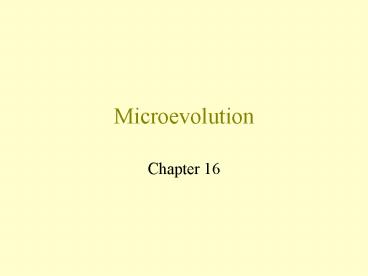Microevolution - PowerPoint PPT Presentation
1 / 18
Title:
Microevolution
Description:
Microevolution- changes in the frequencies of alleles of ... Cockroach traps baited with glucose; cockroaches with aversion to glucose becoming more common ... – PowerPoint PPT presentation
Number of Views:137
Avg rating:3.0/5.0
Title: Microevolution
1
Microevolution
- Chapter 16
2
Overview
- Genetic Variation
- Genetic Equilibrium- a mathematical approach
- Microevolution
3
Microevolution vs. Macroevolution
- Microevolution- changes in the frequencies of
alleles of genes in a population - Macroevolution- the process by which species and
higher groupings of organisms originate, change,
and go extinct
4
Genetics Review
- Homologous Chromosomes?
- Alleles?
- Homozygous/Heterozygous?
5
Variation in Populations
- Polymorphic Alleles
- Polygenic Traits
6
(No Transcript)
7
(No Transcript)
8
Three Factors Determining Genetic Variability
- Rate of mutation
- Rate at which changes spread through a population
- Rate at which deleterious alleles are eliminated
9
How Much Variation?
- About 1/4th of all human proteins have an
alternate form present in at least 5 of the
population - 7 heterozygous for any human gene encoding a
protein - 1 in 500 nucleotides different
- All variation subject to natural selection?
10
Hardy-Weinberg Equilibrium
- Allelic frequencies do not change from one
generation from the next as long as - 1) there is random mating
- 2) there is a large population size
- 3) there are no mutations
- 4) no breeding with other populations
- 5) no selection
11
Hardy-Weinberg Example
- Mussels with two alleles (A and a) for color with
blue being dominant - Fraction of sperm or ova with A allele is p,
fraction with a allele is q (p is 0.6) - What genotypic frequencies will result from
release of these sperm and eggs into seawater?
12
How is this Helpful?
- Consider a genetic disease caused by a single,
recessive gene - 1 in 10,000 babies are born with this disease.
- What is the frequency of individuals who are
carriers of this recessive allele?
13
(No Transcript)
14
Non-Random Mating
- Positive assortative mating
- Negative assortative mating
15
Random Drift
- affects small populations
- does not involve natural selection
16
(No Transcript)
17
Gene Flow
- Increases the variation of a population into
which genes are flowing - Makes adjacent populations more homogenous
18
Natural Selection
- Antibiotic-resistant bacteria becoming more
common - Cockroach traps baited with glucose cockroaches
with aversion to glucose becoming more common






























